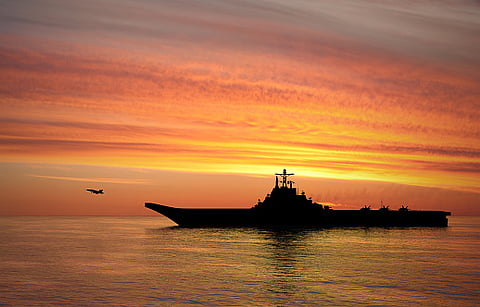
- Home
- न्यूजग्राम
- India
- World
- Politics
- Entertainment
- Culture
- Lifestyle
- Economy
- Sports
- Sp. Coverage
- Misc.
- NewsGram Exclusive
- Jobs / Internships

As India continues to upgrade its defences around its territory, it is also upgrading its fleet in the oceans. The Indian navy is currently going through a massive modernization and indigenization phase. From nuclear submarines and warships to aircraft carriers, the Indian navy is rapidly expanding its fleet size to achieve the goal of becoming a true blue water navy with more than 200 vessels.
India recently launched the Indigenously built INS Vikrant aircraft carrier (IAC-1) and is now looking for some of the most advance and compatible fighter jets for the soon to be commissioned carrier. The carrier is scheduled to be commissioned into the Indian Navy around august this year. India currently doesn't have enough naval fighter jets to operate both of its carriers (the currently operational INS Vikramaditya and the new INS Vikrant) at their full potential and capacity. If India decides to use its existing MIG-29 jets on the Vikrant, it would need to compromise the jet numbers on its INS Vikramaditya carrier.
Because of this reason, it seems that India may go with a direct government to government deal for a new naval fighter Jets, just like the Rafale deal with France.
The Indian Navy initially announced a tender for 57 jets in 2017. It was estimated to be worth at least 6 to 7 billion USD at that time. The Indian Navy now plans to purchase 26 Jets, 18 of which will be single-seaters and the remaining 8 will be two-seaters.
INS Vikrant's capacity:
The INS Vikrant, with its massive 14 decks, has a total of 2300 compartments. It can carry 1700 sailors and officers. It can accommodate about 30 fighters and helicopters. Having a runway length of 206 meters with a ski-jump takeoff design, the carrier has a short takeoff position of 145 meters. As a result, the aircraft chosen by the Indian Navy must be capable of taking off in this manner while carrying all the weapon systems in the full fuel load. The ski-jump design of the carrier limits the variety of jets that can be operated from it.
Rafale vs Super Hornet:
Last month, the Rafale-M jet was tested for 12 days in the goa testing facility of the Indian Navy. On May 21st, the Super Hornet will be tested by the Indian Navy at the testing facility in goa. The US defence major Boeing will be sending two Super Hornet jets to India for the flight and ski-jump tests. Indian Navy will be testing all the operational capabilities of the jet, and may even test the jet on the carrier Vikrant if everything goes well in the ski-jump test.
The Rafale case:
There are two strong contenders in this competition. The Boeing's F/A-18 Super Hornet and Dassault Aviation's Rafale-M. The Rafale is a French origin jet and is already operational in Indian Air Force. As India ordered 36 Rafales and has received most of them, this makes the chances of Rafale getting a follow back order much possible. Also, the Rafale is already operational with the French Navy. But, the French carrier Charles de Gaulle is a CATOBAR ("Catapult Assisted Take-Off But Arrested Recovery" or "Catapult Assisted Take-Off Barrier Arrested Recovery") type carrier, whereas India's INS Vikrant is a STOBAR ("short take-off but arrested recovery" or "short take-off, barrier-arrested recovery") type carrier. The Rafale was designed to operate with a CATOBAR type carrier and not a STOBAR type carrier. Thus, the Dassault Aviation will have to modify the Rafale-M and redesign its wings to make it compatible with the INS Vikrant, if it wants to win the race to supply the Indian Navy with fighter jets. The Rafale is only available in the single-seat configuration unlike the Super Hornet, which is also available in a two-seat configuration. Also, Rafale doesn't have the feature of folding its wings, which the Super Hornet has.
The Super Hornet's case:
The Super Hornet is a US origin fighter jet manufactured by Boeing. It is currently operational in the US Navy and several other navies of the NATO members. It is the primary strike and air superiority jet and is in use for a very long time now. It has features like foldable wings and an option for single or two-seat configuration. According to Boeing, the jet can operate from both STOBAR and CATOBAR type carriers as its design enables all the requirements for the two different types of carriers. Also, when compared to Rafale, the Super Hornet has a shorter wingspan in folded mode, which makes it easier to transport and move the Super Hornet between the decks of a carrier using the deck lifts.
Both the jets are capable and advanced enough to fulfil the requirements of the Indian Navy. Now, it seems that the geopolitical and geostrategic scenarios, the relations between India - US and India - France, and the rapidly changing new world order will most probably affect the decision of India in choosing which jet to go with.
